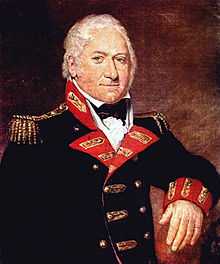Henry Shrapnel
| Henry Shrapnel | |
|---|---|
 | |
| Born |
3 June 1761 Bradford on Avon, Wiltshire, England |
| Died |
13 March 1842 (aged 80) Southampton |
| Nationality | British |
Major General Henry Shrapnel (3 June 1761 – 13 March 1842) was a British Army officer whose name has entered the English language as the inventor of the "shrapnel shell".
Henry Shrapnel was born at Midway Manor in Bradford on Avon, Wiltshire, England, the ninth child of Zachariah Shrapnel and his wife Lydia.[1]
In 1784, while a lieutenant in the Royal Artillery, he perfected, with his own resources, an invention of what he called "spherical case" ammunition: a hollow cannonball filled with lead shot that burst in mid-air. He successfully demonstrated this in 1787 at Gibraltar.[2][n 1] He intended the device as an anti-personnel weapon. In 1803, the British Army adopted a similar but elongated explosive shell which immediately acquired the inventor's name: the shrapnel shell.[5] It has lent the term "shrapnel" to fragmentation from artillery shells and fragmentation in general ever since, long after it was replaced by high explosive rounds. Until the end of World War I, the shells were still manufactured according to his original principles.
Shrapnel served in Flanders, where he was wounded in 1793. He was promoted to major on 1 November 1803 after eight years as a captain. After his invention's success in battle at Fort New Amsterdam on 30 April 1804,[6] Shrapnel was promoted to lieutenant colonel on 20 July 1804, less than nine months later.
In 1814, the British Government recognized Shrapnel's contribution by awarding him £1200 (UK£ 73,000 in 2015)[7] a year for life. Bureaucracy however prevented him from receiving the full benefit of this award.[8] He was appointed to the office of Colonel-Commandant, Royal Artillery, on 6 March 1827. He rose to the rank of lieutenant-general on 10 January 1837.
Shrapnel lived at Peartree House, near Peartree Green, Southampton from about 1835 until his death.[9][10]
References
- Notes
- ↑ According to some historians, the French engineer Bernard Forest de Bélidor actually invented the shell, commonly attributed to Shrapnel.In 1760 de Belidor reported on his secret experiments for the French military with round shells which he called globes of compression. The French inspector general of artillery, Jean-Baptiste Vaquette de Gribeauval, worked on their further development while serving in the Austrian Army during the Seven Years' War.[3][4]
- Citations
- ↑ Sweetman (n.d.)
- ↑ Knight (2013). p. 47.
- ↑ Vesilind (2006) pp. 283-7
- ↑ McCloy (1952)
- ↑ Rich (1967), p. 245
- ↑ Hogg (1970),p. 180
- ↑ Long, Tony (March 2008). "March 13, 1842: Henry Shrapnel Dies, But His Name Lives On". Wired. Archived from the original on 3 June 2008.
- ↑ Sweetman (n.d.)
- ↑ Vale, Jessica (1980). "Peartree House". Lost Houses of Southampton. www.bitterne.net. Retrieved 22 June 2012.
- ↑ "Peartree House". Port Cities: Southampton. www.plimsoll.org. Picture from 1930. Retrieved 22 June 2012. Check date values in:
|date=(help)
- Sources
- Hogg, Oliver Frederick Gillilan (1970). Artillery: its origin, heyday and decline. London: C. Hurst & Company. ISBN 978-0-900966-43-9.
- Knight, Roger (2013). Britain Against Napoleon: The Organization of Victory, 1793-1815. London: Allen Lane. ISBN 978-1-846-14177-5
- McCloy, Shelby Thomas (1952). French inventions of the eighteenth century. Lexington, Kentucky: University of Kentucky Press. OCLC 560969.
- Rich, Norman N. (1967). "Shrapnel Wounds". The Journal of the American Medical Association 202 (3). doi:10.1001/jama.1967.03130160119038.
- Sweetman, John (n.d.). "Shrapnel, Henry" in Oxford Dictionary of National Biography Online (subscription only), accessed 15 March 2014.
- Vesilind, P. Aarne (2006). "Peace Engineering". Journal of Professional Issues in Engineering Education and Practice 132 (4) doi:10.1061/(ASCE)1052-3928(2006)132:4(283).
|